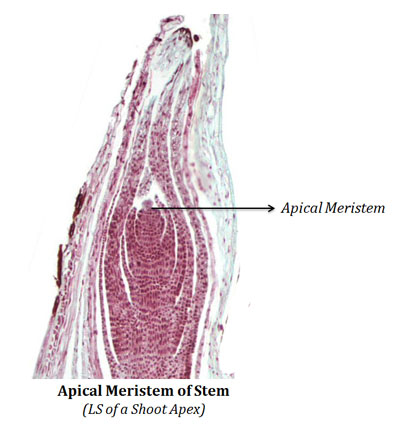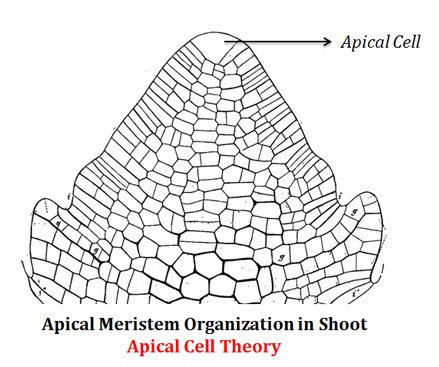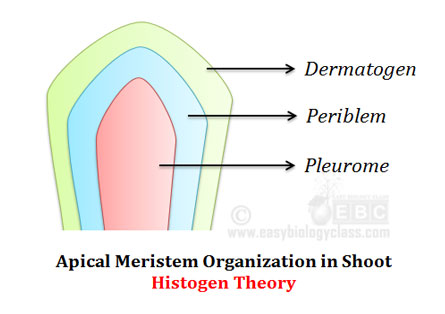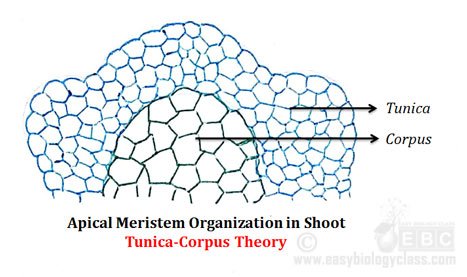Apical meristem
Ø Apical meristem is a patch of meristematic tissue present in the apex (tips) of shoot and roots in plants.
Shoot apex
Ø Shoot apex is the growing tip of the stem.
Ø It is an undifferentiated region with meristematic cells.
Ø From this region the plant growth proceeds.
Ø The shoot apex also produces lateral organs such as leaves, branches and flowers.
Ø Below the apical meristem, different tissue zones are progressively differentiated.

Tissue zones in the shoot apex
Ø Three main tissue zones are present on the shoot apex of plants, they are:
$. Protoderm: Protoderm gives rise to the epidermis of the plant.
$. Procambium: Procambium gives rise to primary vascular tissue (xylem & phloem).
$. Ground meristem (fundamental meristem): The ground meristem gives rise endodermis, pericycle, cortex, medulla and pith.
Theories explaining the organization of Apical Meristem in Shoots
Ø There are THREE theories which explain the shoot apical organization:
(1). Apical cell theory
(2). Histogen theory
(3). Tunica-Corpus theory
 (1). Apical cell theory
(1). Apical cell theory
Ø Apical cell theory was the first theory to explain the apical organization in plants.
Ø This theory is proposed by Nageli in 1858.
Ø The apical cell theory says that a single apical cell constitutes the growth point in most of the cryptogams. This single cell is called the ‘APICAL CELL’. The activity of this single apical cell leads to the development of the complete plant body.
Ø Nageli proposed that the shoot apex of Gymnosperms and Angiosperms also consisted of a single apical cell. However, later studies rejected the apical cell theory because the single-celled apical organization is limited only to cryptogams (algae, fungi, bryophytes and Pteridophytes).
(2). Histogen Theory
Ø The Histogen theory is proposed by J. Hanstein in 1868.
Ø Hanstein proposed the histogen theory based on two considerations:
(a). The plant body does not originate from a single superficial cell, but from a mass of meristematic cells.
(b). This meristematic zone consists of three distinct zones called HISTOGENS.
Ø The three histogens according to Hanstein are:
$. Dermatogen: The outermost laver which gives rise to epidermis.
$. Periblem: Located inner to the dermatogen, consists of a few layers of cells. Periblem gives rise to the cortex.
$. Plerome: The central core of cells which gives rise to vascular tissue and endodermis.

Ø According to histogen theory, each plant part originates from a group of initials.
Ø The histogen theory is now rejected. This is because recent studies have shown that there is no strict zonal differentiation between the histogens in the shoot apex meristem. Thus, we cannot distinguish dermatogen, periblem and plerome from each other in the apical region.
(3). Tunica Corpus Theory
Ø Tunica corpus theory is proposed by Schmidt in 1924.
Ø According to the Tunica Corpus theory, two distinct tissue zones occur in the apical region of the shoot. They are:
(a) Tunica: Consists of one or more peripheral layer of cells.
(b). Corpus: Consists of a mass of cells overarched by the tunica.
Ø Cells of tunica are:
$. Smaller than corpus
$. Show anticlinal division
$. They assist in increasing surface area
Ø Cells of corpus re:
$. Larger than tunica cells
$. Divide in all plains
$. They assist in increase volume

Ø The outermost layer of tunica produces epidermis. The Cortex, endodermis, pericycle, vascular tissue and pith are produced from innermost layers of tunica and whole of the corpus.
Ø Tunica Corpus theory is the currently accepted theory of apical organization of shoots in plants.
<<< Back to PLANT ANATOMY Notes
| You may also like... | ||
|---|---|---|
| NOTES | QUESTION BANK | COMPETITIVE EXAMS. |
| PPTs | UNIVERSITY EXAMS | DIFFERENCE BETWEEN.. |
| MCQs | PLUS ONE BIOLOGY | NEWS & JOBS |
| MOCK TESTS | PLUS TWO BIOLOGY | PRACTICAL |
You might also like…
@. Meristem: Structure and Classification
@. Characteristics of Meristematic Cells
@. Meristem vs Permanent Tissues

thanks a lot it has been so helpful ,its really explained well
Sir, what is continuing meristematic residue and cyto-histological zonation?
Easy language used
Thanks..it helps me a lot
I need note on root apical meristem
Shoot apical meristem is very clearly understand thk u fr tht
I wnt ans fr root apical meristem
what is cytohistogenic theory?
how the vascular tissue differentiate in flowring plant?
I don’t understand that histogen theory was rejected on the basis that there is no zonal differentiation in shoot apex meristem….. But in tunica corpus theory says there are two zonal differentiation…. How it can be possible…?
You cannot see dermatogen, periblem and pleurome.. there is not clear zonal differentiation in the root apex as described in the Histogen theory. However, we can clearly differentiate the outer layer of cells in the shoot and root apex from rest of the cells. The outer layer cells are smaller than the inner cells. more than that the outer layer of cells and inner mass of cells shows difference in the division planes.
Home you understand..
Regards
Hope*